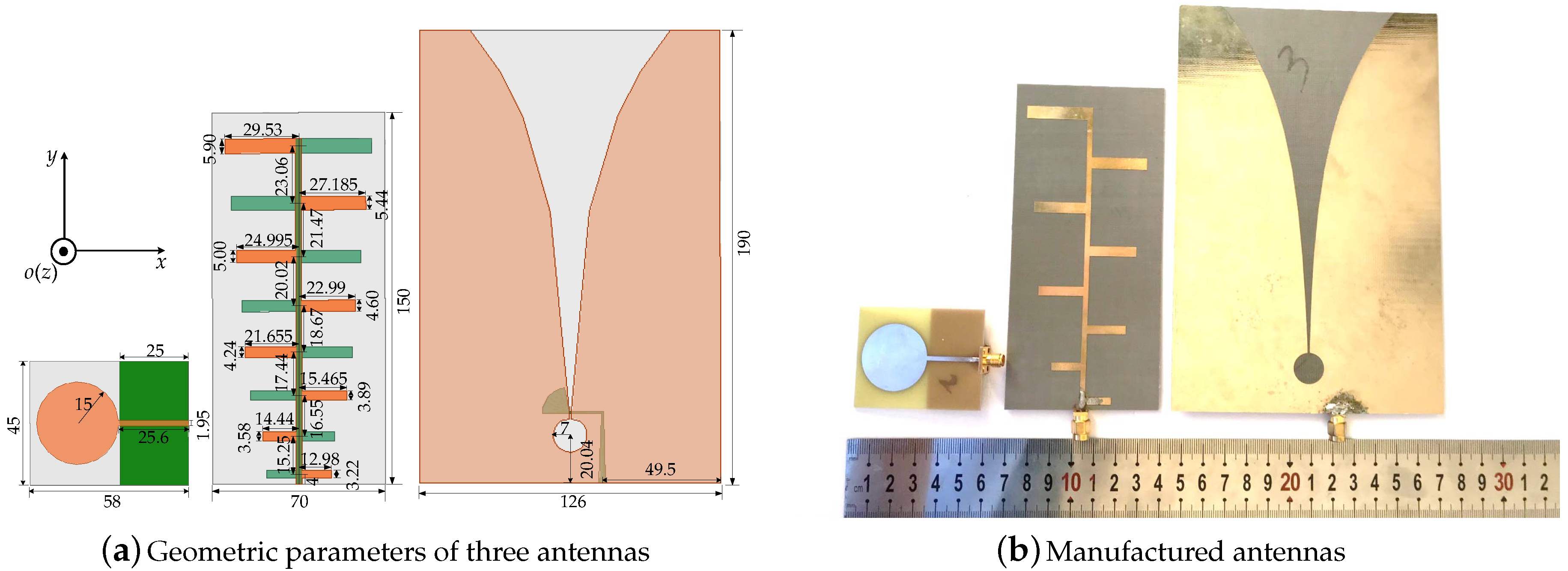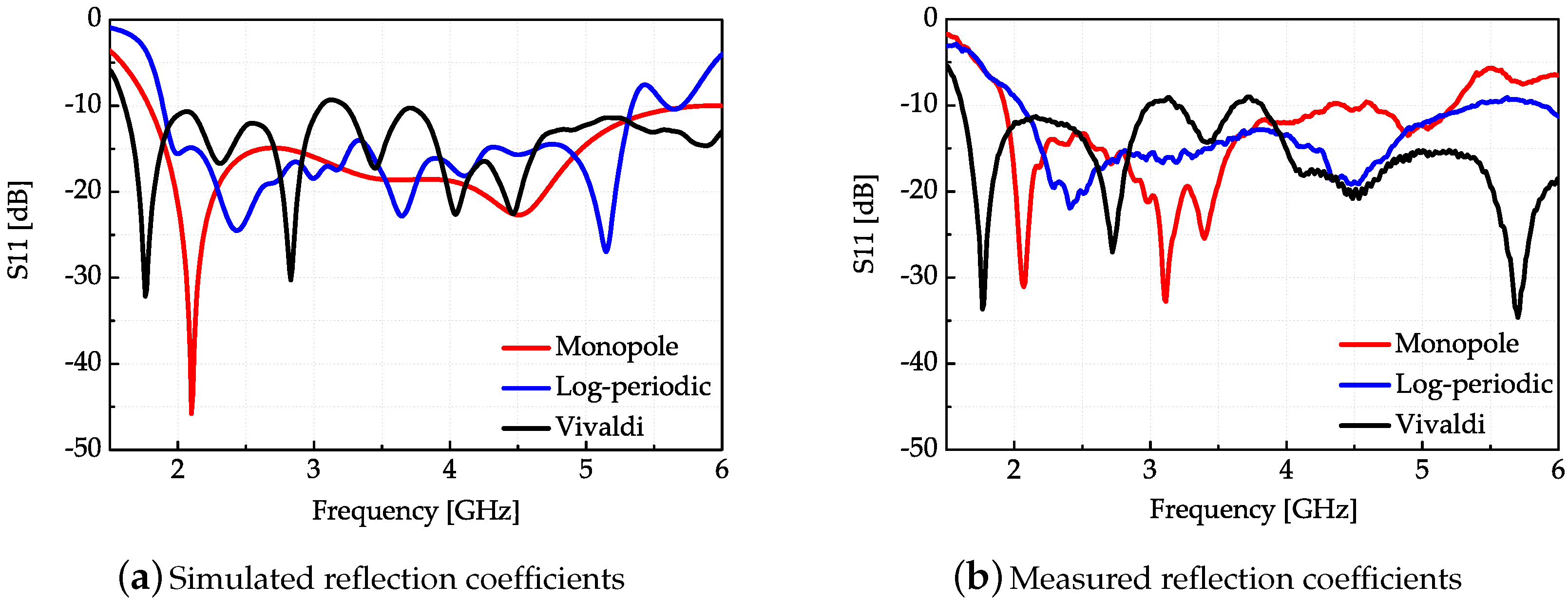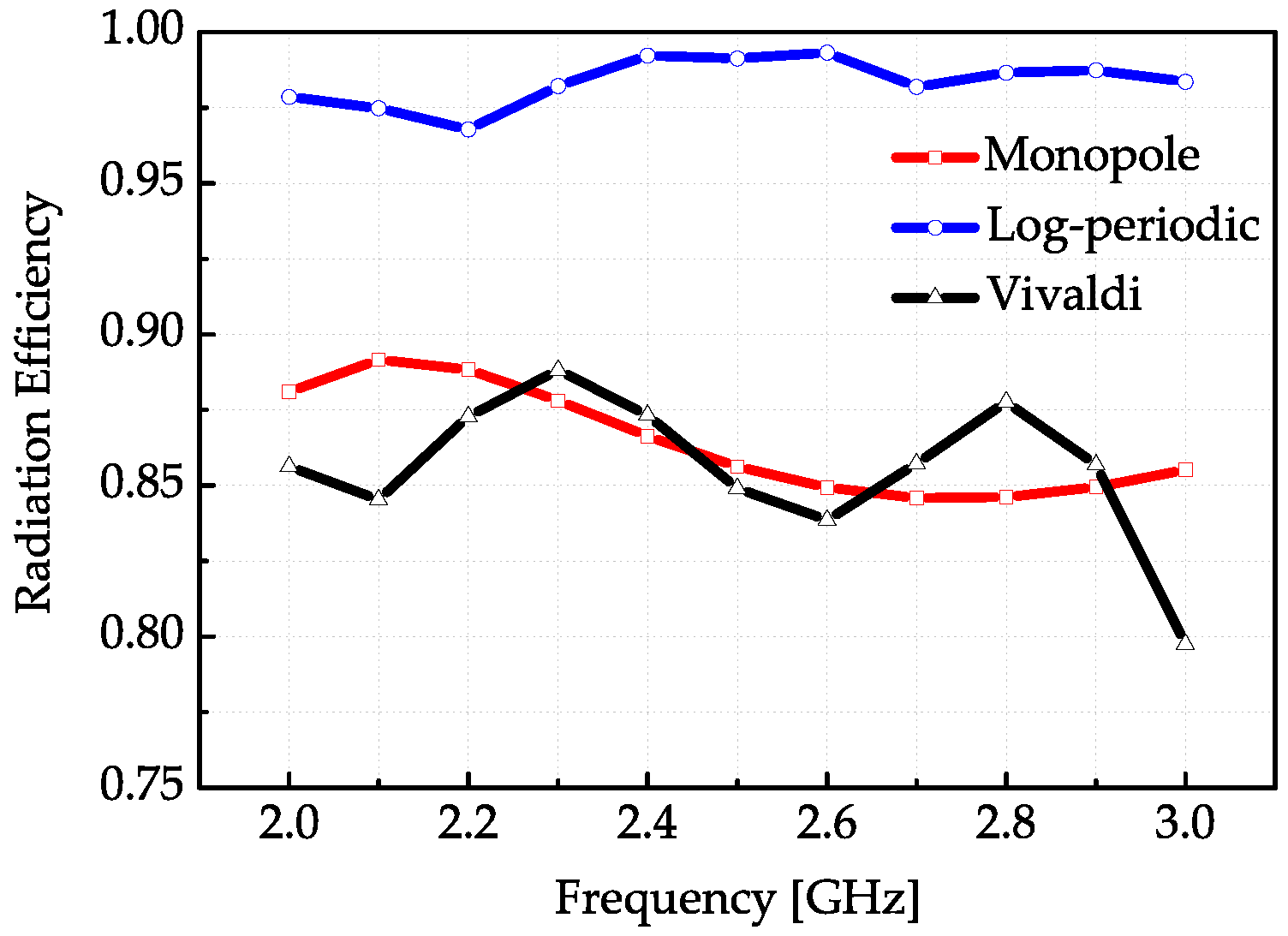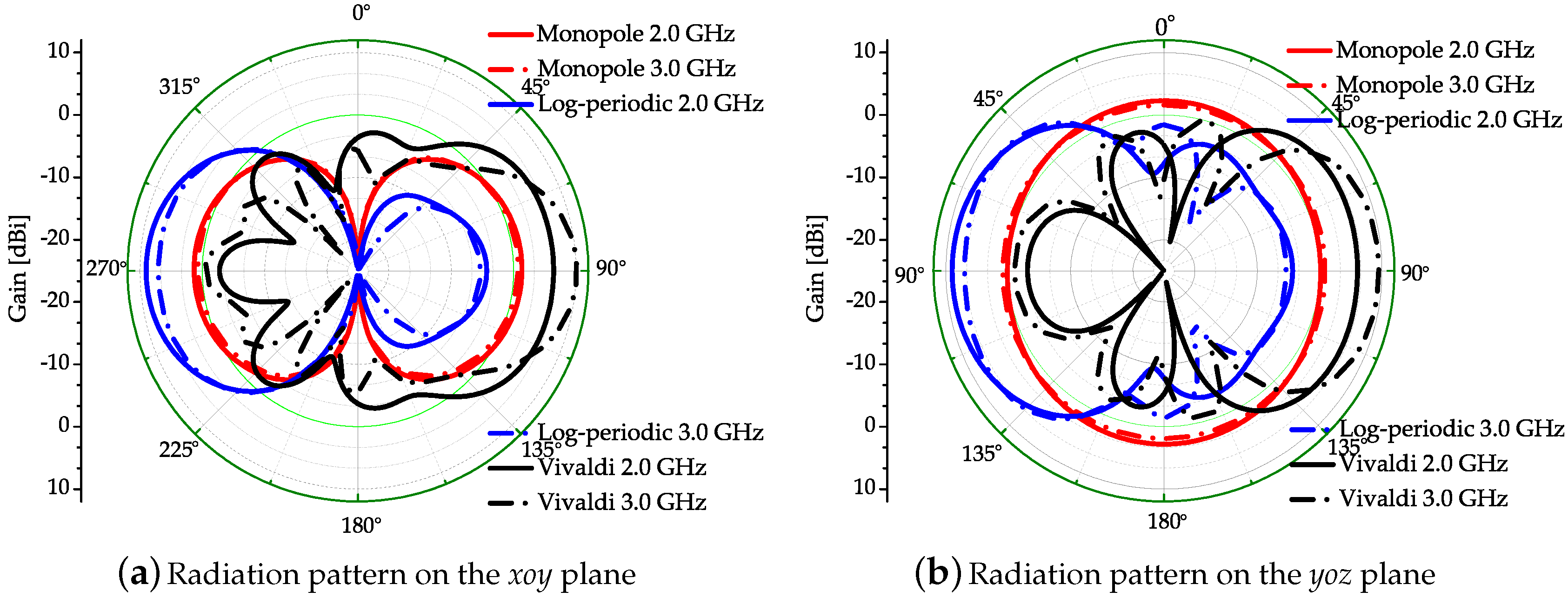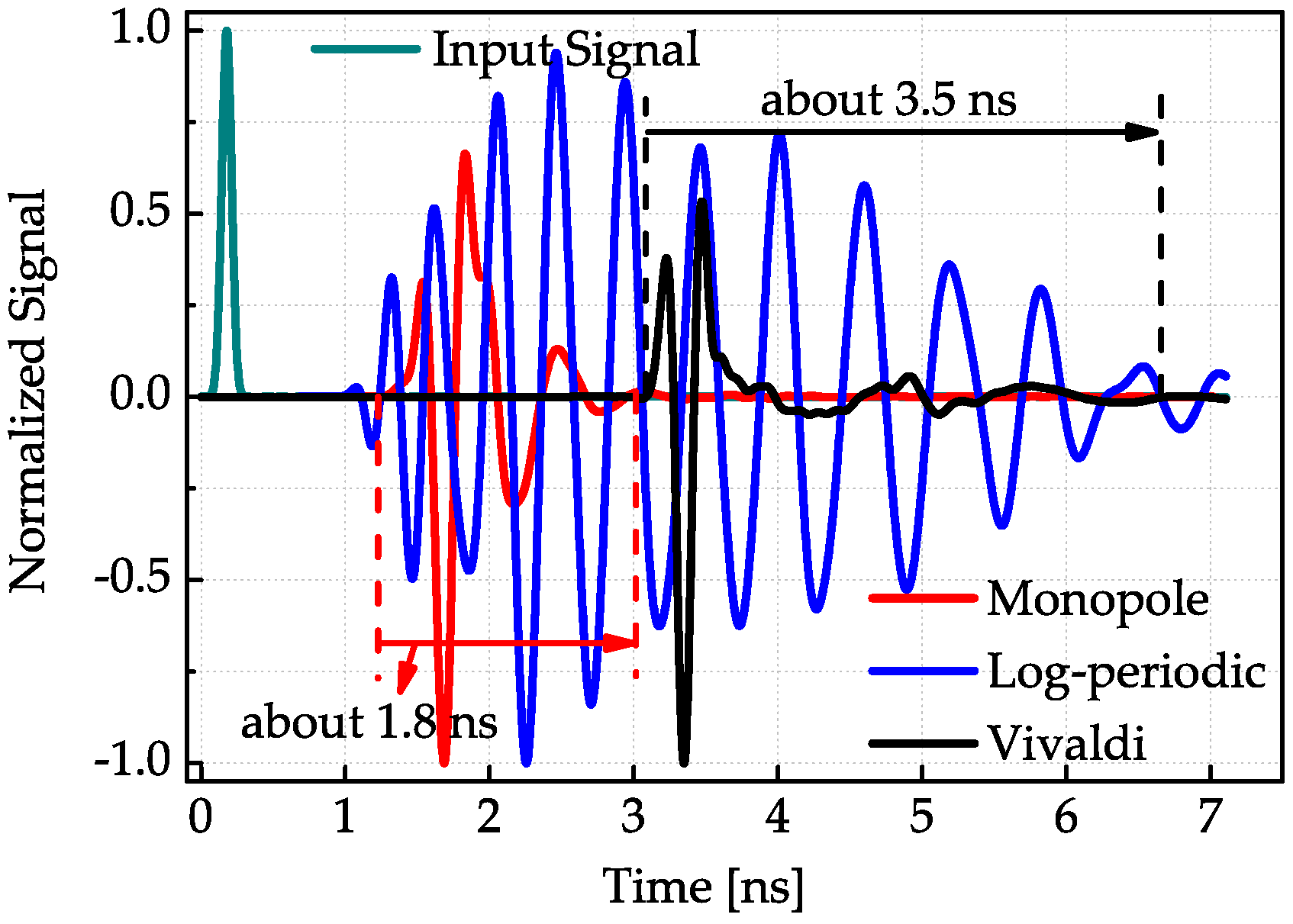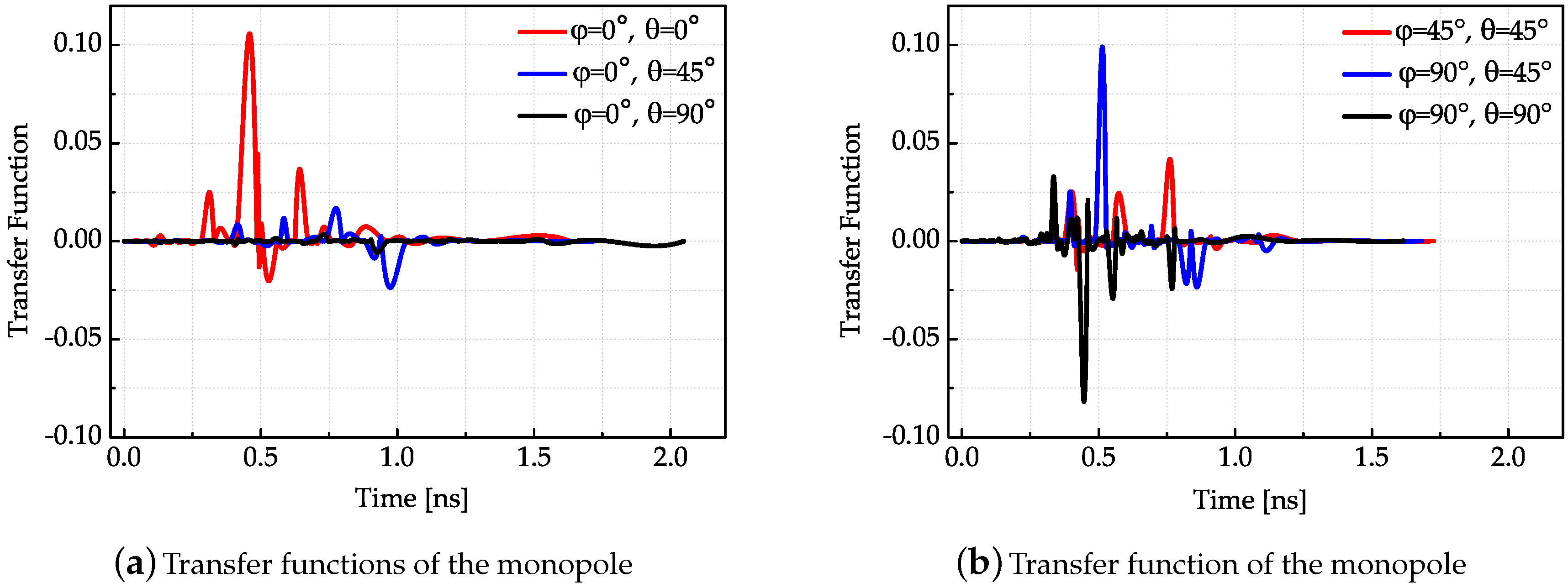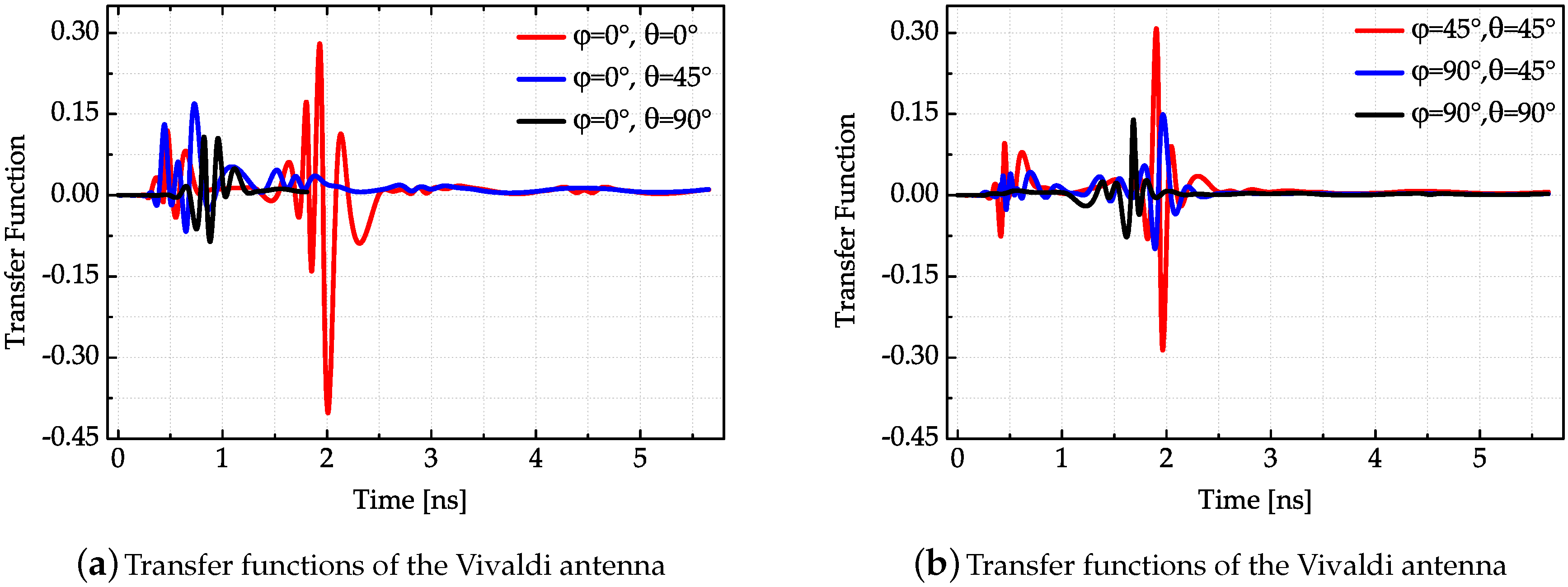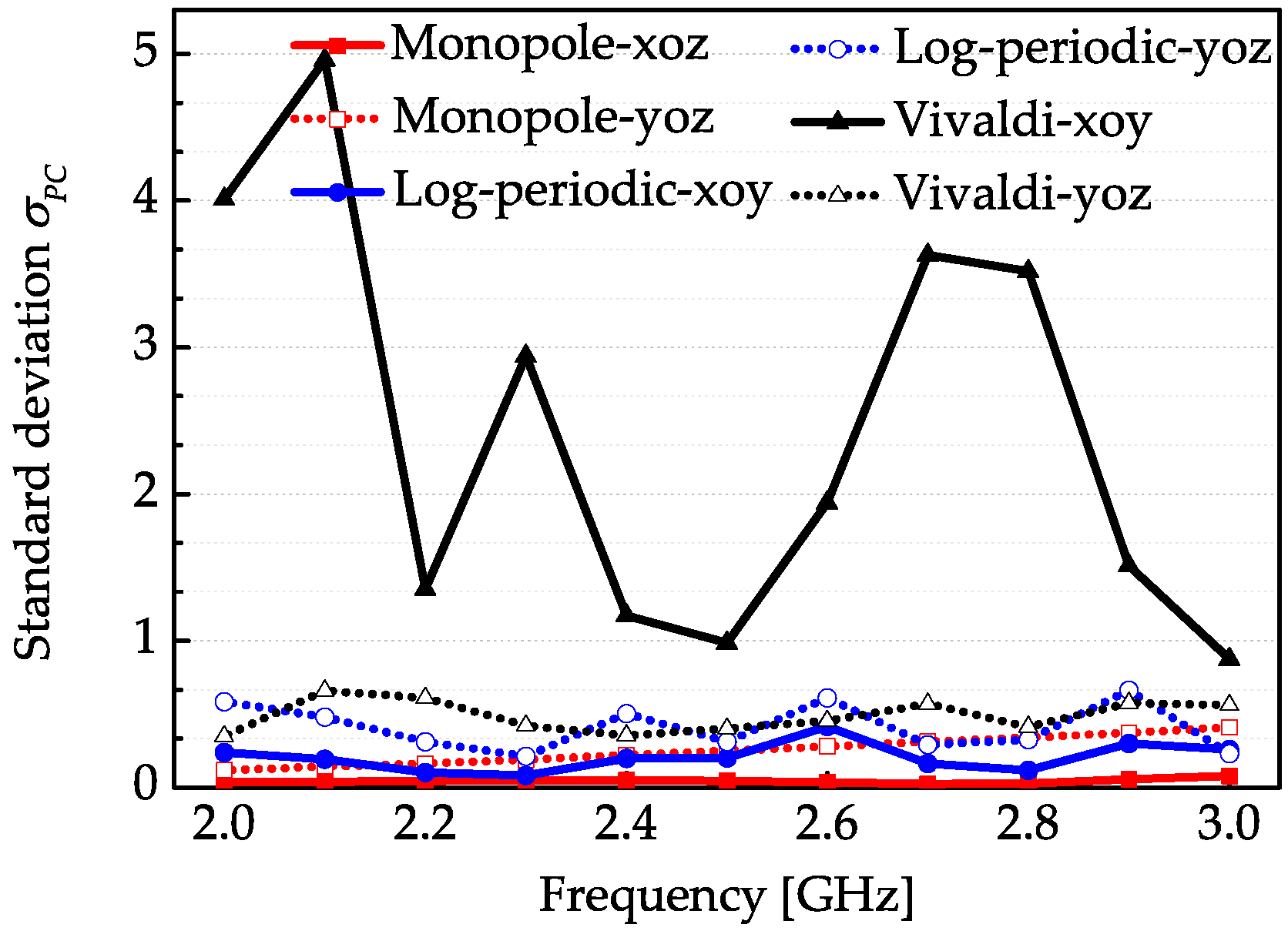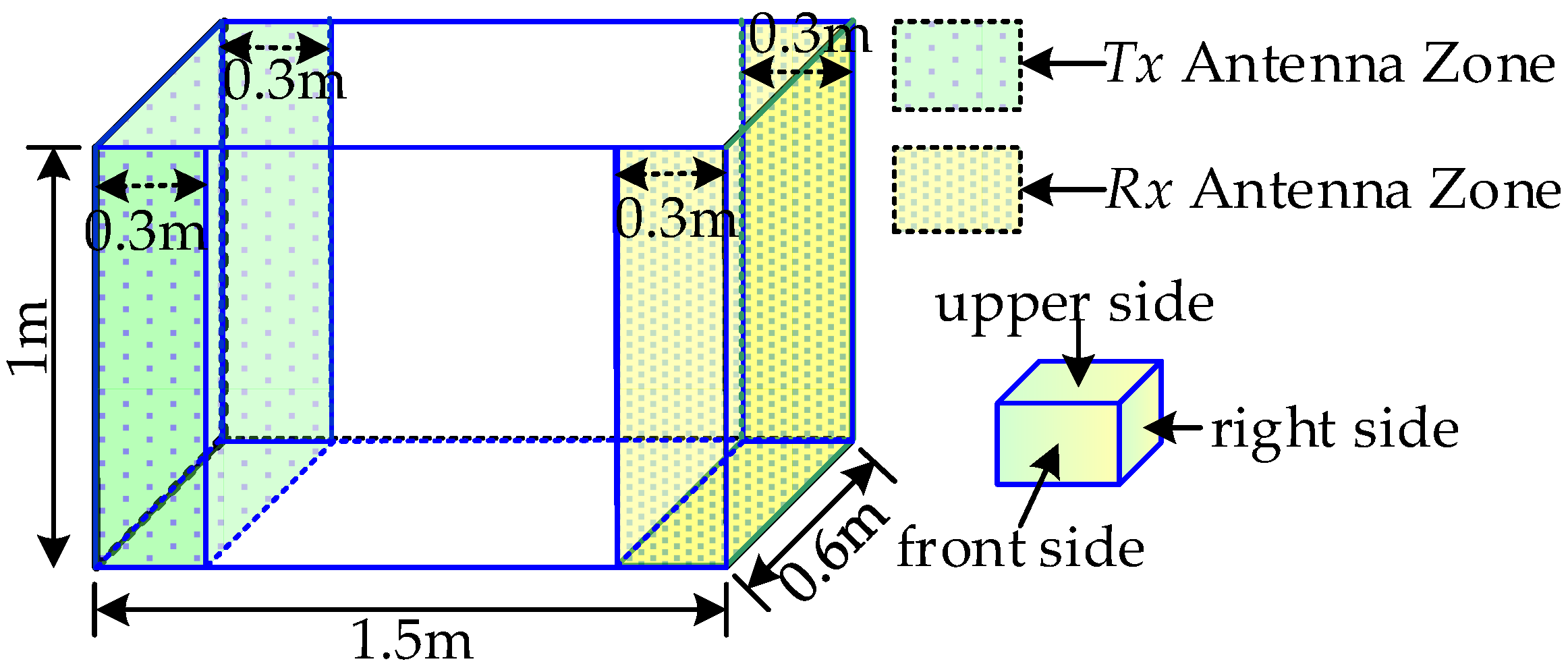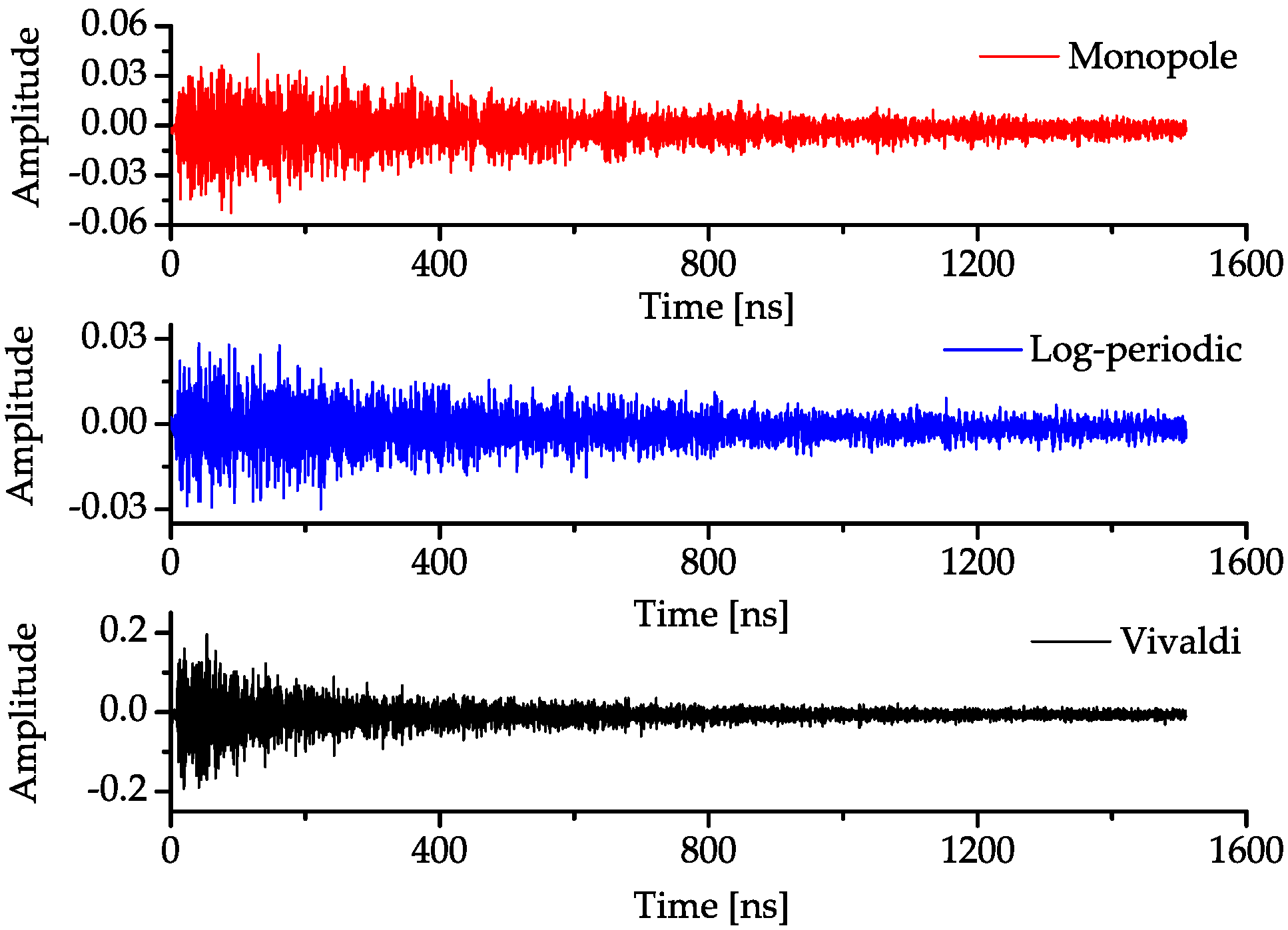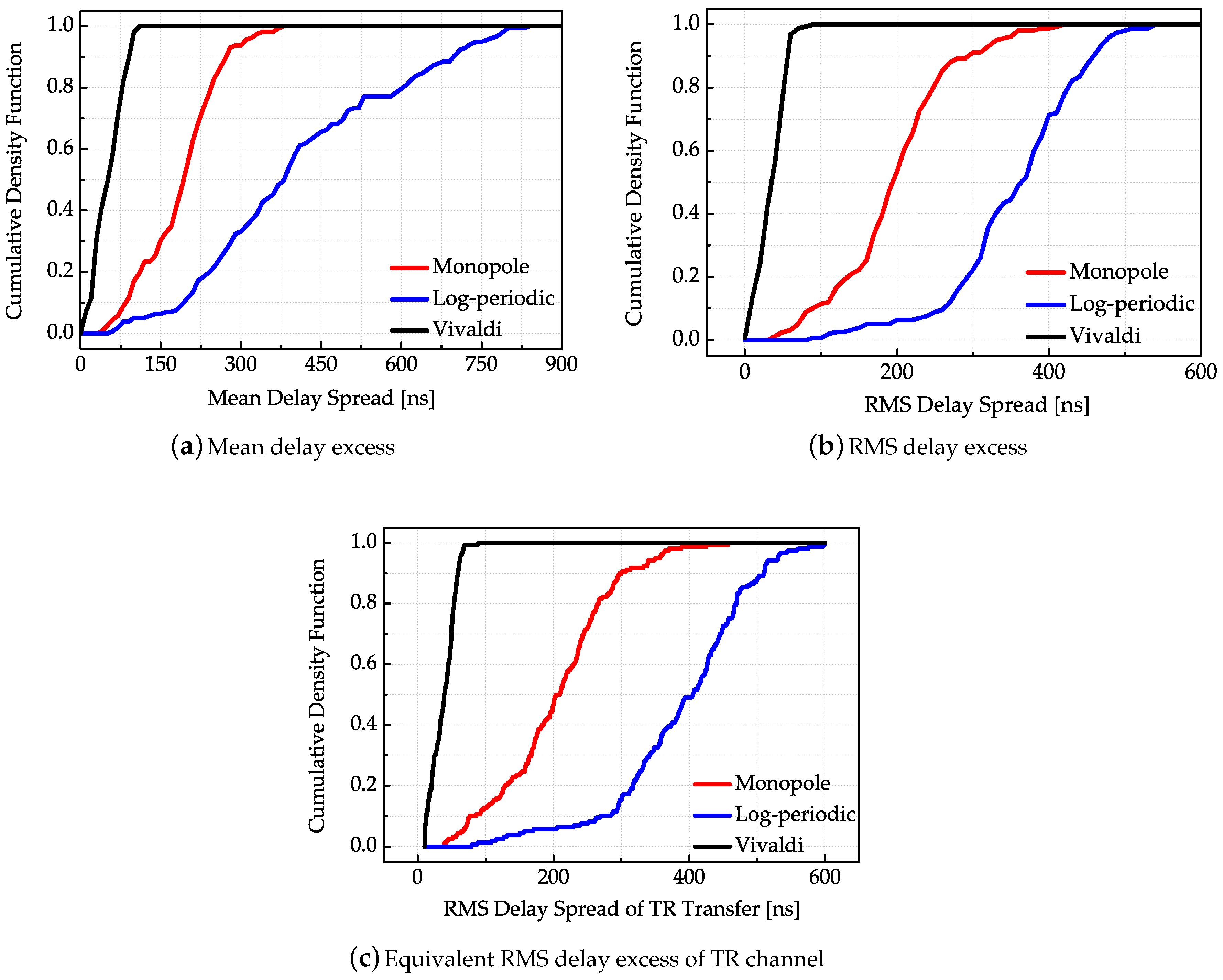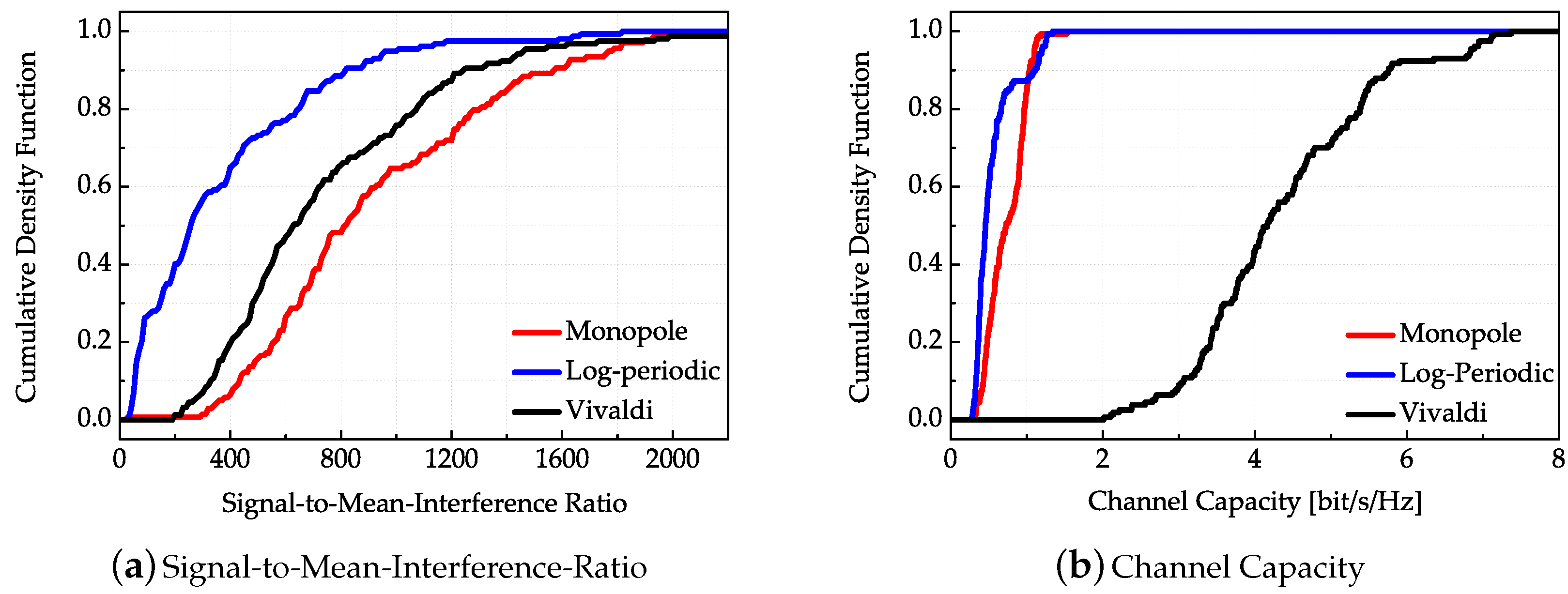1. Introduction
Ultra-wideband (UWB) has been applied in various wireless sensor networks (WSNs) due to their low complexity, low cost, low interference and high time domain resolution [
1]. One central issue facing the UWB community is how to effectively collect energy, which is dispersed in a rich multipath. Time reversal (TR) is a self-adaptive technique that can be used to compensate for any geometrical and channel distortions due to the propagation through inhomogeneous media [
2]. Moreover, it has been proved to be an ideal paradigm in suppressing the time delay spread caused by the rich multipath, and an extremely simple non-coherent receiver can be used for low-cost and low-power sensors based on the TR technique [
3,
4].
In UWB radio wave propagations, the multiple scattering effect contributes to the temporal dispersion of the pulsed shaped transmit signals and the multiple diffraction of incident wave leads to the distortion of the incident wave [
5]. An accurate uniform theory of diffraction (UTD) model for the analysis of complex indoor radio environments is presented by taking into account the effects of building floors, walls, windows, and the presence of metallic and penetrable furniture into account [
6]. Moreover, the measurement and modelling of spatial channel, such as indoor channels, warehouse environments, parked cars in underground garages, and foliage environments have also investigated the propagation of UWB signals [
7,
8,
9,
10]. The efficient algorithm for channel response extraction such as cluster identification and the power delay profile (PDP) model have also been developed [
11].
In a practical pulse radio UWB system, the parameters and positions of antennas will significantly influence the power gain of the transmission link, thus the radiation properties of mounted antennas in UWB communication system must be considered in the system deployment [
12,
13]. The pulse distortion of the UWB antennas will inevitably reduce the system performance, and physical or numerical methods can compensate this kind of distortion [
14,
15], but they are complex and not appropriate for some low-cost and low-power sensors system. Furthermore, waves propagating through dense multipath environment such as the inner space of a closed cavity (vehicle, airplane, spacecraft etc.) will lead to time-spreading of pulses and make signal transmission less predictable and less reliable in sensors system [
16,
17]. The TR technique can adaptively compensate pulse distortion with a simultaneous spatial-temporal focusing property; thus, it is necessary to investigate the antenna and radio propagation performance in a UWB sensors system based on a TR technique when deployed in complex environments.
It is well known that the time dispersion property of a UWB antenna will decrease the signal-to-noise ratio (SNR) of the UWB communication system, and antennas with larger time dispersion generally have less stable phase centers [
18]. The directive antenna generally has larger antenna gain than the omnidirective antenna and will produce a larger channel gain in line-of-sight transmission, while some directive antennas also have worse dispersion properties, which means larger interference in communication than the omnidirective antenna [
19]. Although some antennas such as the transverse electromagnetic wave (TEM) horn antenna, ridged horn and dielectric rod antenna share high gain and low dispersion properties simultaneously, they are not easily integrated in UWB sensors’ application. Therefore, how to achieve a balance between the antenna dispersion and antenna gain in a specific deployment using easily integrated planar antennas deserves attention.
In order to explore the trade-off between antenna gain and time dispersion property in TR based UWB communication systems, we use three kinds of typical planar antennas (i.e., monopole, log-periodic and Vivaldi antenna) with different radiation patterns and transfer properties to measure the channel response and then to evaluate the system performance. The measurements are deployed in a closed metal cavity that is used to simulate an enclosing cabin and produce multipaths. Results show that the larger antenna gain cannot effectively compensate for the capacity loss caused by the antenna dispersion to a certain extent in TR UWB communication, and the impact of phase center on the channel capacity is not obvious. In addition, antennas with smaller time dispersion have better energy focusing and anti-interference performance in TR UWB systems.
The rest of this paper is organized as follows. In
Section 2, the theoretical foundation of UWB communication based on TR in WSNs is presented and the measured parameters are defined. The characteristic parameters of antennas are displayed in
Section 3.
Section 4 introduces the experimental setup in detail. The measured results and discussions are addressed in
Section 5.
Section 6 concludes the whole paper.
2. Theoretical Foundation of Time Reversal UWB Communication
The basic principle of pulse-based TR UWB communication in WSNs is as follows. In the first phase, the receiver (
Rx) antenna sends a probing signal to the transmitter (
Tx) antenna and the
Tx will estimate the channel response. In the second phase, the
Tx antenna transmits information symbols that are modulated by the time-reversed channel response [
3]. The complete transmission link including antenna effects and spatial propagation in frequency domain based on channel reciprocity is derived and the equivalent TR channel response is also obtained. The complete transfer structure of the TR UWB system in time domain is presented in
Figure 1a and the transfer scheme in frequency domain is presented in
Figure 1b . When the signal is transmitted through a UWB antenna, the antenna output signal contains the input signal and its derivatives with varying delays, caused mainly by the resonances in the radiator structure. The radiated electromagnetic fields are derived from the differentiation of the current/charge distribution on the antenna [
18].
The parameters used in the time-domain link description are: amplitude of Tx signal in ; amplitude of Rx signal in ; angle-of-departure of ray at the Tx antenna ; angle-of-arrival of ray at the Rx antenna ; amplitude of the equivalent TR receive signal in ; transfer function of Tx antenna ; transfer function of Rx antenna ; characteristic impedance of Tx antenna in ; characteristic impedance of Rx antenna in ; wave impedance of the free space in . In addition, the corresponding descriptions in the frequency-domain link description are: amplitude of Tx signal in ; amplitude of Rx signal in ; amplitude of the received equivalent TR signal in ; transfer function of Tx antenna ; transfer function of Rx antenna .
Assuming the total number of the transmission paths is
P, then the incident signal of the
pth path with amplitude fading factor
and path delay
at the receiver is modeled as follows:
where
is the Dirac delta function and * denotes the convolution operator. The transfer function of the
Tx antenna is
, it contains the co-polar component
and cross-polar component
of the antenna transfer function,
is the unit vector in the co-polar direction and
is the unit vector in the cross-polar direction. Since the channel is reciprocal, the linearity of the problem allows for the superposition of all incident plane waves at the
Rx antenna, and then the total received electrical signal at the
Rx antenna can can be expressed as
Then, the received signal at the
Rx end is the convolution of the incident signal with the
Rx transfer function, which is denoted as
where
is the transfer function of the
Rx antenna. Substitute (
2) into (
3) can obtain the expression of the
Rx signal as:
The system transfer function in time domain is obtained in (
4), after Fourier Transform, the equivalent system transfer function in frequency domain can also be expressed as
where
is the amplitude fading factor and
is the phase shift. The total channel response in frequency domain with the antenna transfer functions and the fading effects in the free space included is thus obtained in (
5).
In TR UWB communication, channel estimation is in the first phase, and then the time-reversed version of the estimated channel response will be used to modulate the transmitted signal
in the second phase. Since the channel is reciprocal, the input signal of the
Tx antenna in TR UWB communication can be written as
where
is the maximal path delay of the channel response, due to the path delay being generally larger than the time dispersion of the antenna transfer function. The antenna transfer functions
and
are the time reversed version of the antenna transfer function with stationary time delay. Similar to the process in (
2), the total incident signal at the
Rx antenna is
Similar to the derivation of (
4), the received signal at the
Rx end in the TR communication is
Substituting (
6) into (
8), and assuming the characteristic impedances
and
are equal, the equivalent TR channel response in the time domain can be written as
In (
9),
is the auto-correlation function, i.e.,
. Similarly,
is the mutual correlation function.
represents the absolute value of the variable,
is the module of the vector, and
is the conjugate of the variable. The equivalent TR channel response
in (
9) can be turned into frequency domain by Fourier Transform, and it contains two parts: the signal component
and the interference component
. Their expressions are:
In (
10)–(
12), it can be seen that the equivalent TR channel response depends on the spatial multipath transmission as well as the antenna transfer functions both at the
Tx and
Rx end. The spatial channel response and antenna transfer functions can all be measured precisely in the time domain or frequency domain.
4. Experimental Setup
All of the measurements are performed in a metal cavity shown in
Figure 11. In
Figure 11, the left shaded zone of the cavity is where the
Tx antenna is located and the shaded zone at the right is the location of the
Rx antenna. The dimension of the cavity is 1.5 m × 0.6 m × 1 m. The
Tx and
Rx antennas are independently and randomly placed on the respective location areas. The backward side i.e., the ground of these antennas is attached to the center of a 30 cm × 30 cm foam base with a thickness of 6 cm, and then the foam base is adhered to the metal wall. Firstly, each
Tx or
Rx area is divided into uniform grids that have the same areas as the foam with serial numbers. In addition, then the
Tx or
Rx is independently placed on the numbered grid according to the pre-generated random number with equal probability. The orientation of the
Tx and
Rx antennas are also independently random. No matter which side the antenna is placed on, the positive direction of the
y-axis (in
Figure 2) has four choices and each with probability 1/4. When the antenna is on the front or backward side, the direction of the positive
y-axis can either be along the upper, lower, left or right side. In the same way, once the antenna is placed on the left or right side, the positive
y-axis can be along the upper, lower, front or back side. Lastly, the direction of the positive
y-axis can be along the front, back, left or right side when the antenna is placed on the underside. The measured times of each position will be five and the measured position of each pair of antennas is one hundred.
This chamber used here can be described as a metal cavity that supports a large amount of resonant cavity modes [
21]. Substituting the cavity dimension in this experiment into the calculation of resonant frequency in the resonant cavity, the calculated result shows that there are 2925 modes between the bandwidth 2–3 GHz with a mean frequency interval of 0.34 MHz under the ideal condition. It indicates that almost all waves in measured bandwidth can exist in this cavity. As shown in
Figure 12, the experimental process is as follows: firstly, the Arbitrary Waveform Generator (AWG) is used to generate a Gaussian signal with sampling frequency 12 GHz, truncated threshold 10 dB, bandwidth 2–3 GHz and total power of one Watt; subsequently, the signal is amplified by a power amplifier (PA), transmitted through one antenna, propagating in the metal cavity, received by another of the same antenna, and finally recorded by the Digital Serial Analyzer (DSA) with sampling frequency 6.25 GHz. All measurement processes are controlled and operated by the central computer. The
Tx and
Rx antennas are connected with the devices using coaxial cables through the holes on the cavity wall.
5. Results and Discussion
All the transmitted pulses in every measurement are of the same amplitude and time duration, and the original received signals during one measurement that contains noise are shown in
Figure 13. In addition, the noise will then be filtered out using the LMS filter. A typical deconvolution algorithm called the CLEAN algorithm is used to calculate the transmission responses [
22]. The template signal is the input Gaussian signal with bandwidth from 2 GHz to 3 GHz at the
Tx antenna, and the received signal is the output signal at the
Rx antenna. In this way, the measured response is the convolution of the antenna transfer functions and spatial channel responses. The algorithm stops when correlations within a threshold from the strongest path cannot be found. For these measurements, the onset of “phantom paths” as characterized by a sharp increase in both the total number of detected multipath components and delay spreads, which occurred for a threshold of 30 dB. A threshold of 28 dB produced a correlation of 91–96% for both monopole and log-periodic antennas and energy capture ratio of 89–95%. Moreover, a threshold of 26 dB produced a correlation of 90–95% and the energy capture ratio is 86–92% for the Vivaldi antenna.
In
Figure 13, measured results show that the Vivaldi antenna has a maximum channel gain while the log-periodic antenna has a minimum gain on average. The main lobes of the log-periodic and Vivaldi antenna are along the
y-axis while the main lobe of the monopole is along the
z-axis. Therefore, the signals transmitted by the log-periodic and Vivaldi antenna will undergo more reflections before reaching the
Rx antenna under most of the measurement conditions. Since the pulse that was transferred by the log-periodic antenna has a larger time spread, the signal energy will dispersed in a larger time duration, which means that the amplitude of the signal will become smaller. After long distance propagation, the signal with a smaller amplitude will be received with larger attenuation, and a part of the signals will be at the same level with the noise. This is the reason why the average channel gain of the system composed by log-periodic antennas is smaller than the system composed by the monopoles, even if the gain of the log-periodic antenna is much larger than the monopole. The energy of the radiated signal of monopole is more centralized than the log-periodic antenna, and the larger gain of the log-periodic antenna cannot compensate its dispersed signal energy in this case. Similarly, the dispersion of the Vivaldi antenna is larger than that of the monopole, but its larger gain can compensate for the dispersion of the radiated signal energy; thus, the average channel gain of the Vivaldi antenna system is the largest.
The stability of phase center in a UWB antenna is related to the radiation mechanism and feed structure employed to excite the antenna. The phase center of the Vivaldi antenna has the worst stability here due to its unsymmetrical feed structure, and it does not affect the intensity of the radiated signal. According to the above analysis, in the given measurement environment, the weakened signal intensity caused by the antenna dispersion is the main reason or the received small amplitude signals.
Thus, the stability of the phase center does not have a direct interconnection with the performance of the TR UWB communication systems.
The power delay profile (PDP) is characterized by the first central moment (mean excess delay) and the square root of the second moment (root mean square (RMS) delay spread). The RMS delay provides a figure of merit for estimating data rates of the TR UWB sensors system [
10] due to the fact that the equivalent TR channel response in time domain is just the self-convolution of the unidirectional transmission response. This means that, once the unidirectional response is obtained, the equivalent TR channel response can be correspondingly calculated. The cumulative density functions of the mean delay spread and RMS delay spread of the unidirectional and TR transmission are shown in
Figure 14.
The results in
Figure 14 show that the Vivaldi antenna has both the minimum mean delay spread and RMS delay spread. This is intuitive because of its largest channel gain. For the setting of the given threshold value, multiple paths of the Vivaldi antenna with extremely lower amplitudes are regarded as noise thus being filtered out. Similarly, the channel gain of the log-periodic antenna pair is relatively the smallest; thus, more multipath components are detected above a given threshold with larger path delay. Because of the temporal focusing effect of TR transmission, most of the energy is focused on the path with maximal transmission gain, the cumulative density functions of the mean excess delay corresponding to equivalent TR transmission are highly concentrated, but the RMS behaves differently by observing
Figure 14c. Because of its overall highest transmission gain, the Vivaldi antenna has the smallest RMS delay spread in the TR transmission while the log-periodic antenna correspondingly has the largest RMS delay spread. The reason is the same as in the unidirectional transmission.
When the signal is detected at the receiver in pulse-based TR UWB sensor systems, only a threshold decision is needed to detect the information symbol and its value depends on the maximum transmission gain. All other taps of the equivalent TR transmission link in time domain can be regarded as interference. The larger the threshold, the better anti-interference performance the TR system possesses. In order to precisely describe the energy focusing performance that is closely related to the detection error rate and anti-interference performance of the TR system, we define here a metric that is signal-to-mean-interference ratio (SMIR). The SMIR is the ratio between the maximum equivalent TR transmission gain and the mean interference of other taps. Thus, according to (
10)–(
12), it can be denoted as
in frequency domain. The SMIR performance can be calculated by the measured antenna transfer function and channel responses in frequency domain.
The cumulative density functions of the SMIR are exemplified in
Figure 15a. The results show that the monopole antenna has the best SMIR performance while the log-periodic antenna has the worst SMIR performance. In other words, the monopole antenna has the best energy focusing ability and anti-interference performance while the log-periodic antenna possesses the worst energy focusing ability. Although the channel gains of the Vivaldi antenna are all relatively the largest, while the gains of the log-periodic antenna are the smallest, they have smaller ratios between the main path power and the average interference path power than the monopole antenna. The SMIR performances are in accordance with the antenna dispersion properties, which means that the smaller antenna dispersion can obtain better energy focusing property and anti-interference property. The cumulative density functions of evaluated channel capacities corresponding to each TR transmission are demonstrated in
Figure 15b. Using the classical Shannon capacity formula, the measured time domain channel response is firstly turned into the frequency domain, and then the frequency band is divided into 1024 sub-bands, where each sub-channel can be considered as frequency-flat, and then integrate the channel capacity for the sub-bands over the whole bandwidth [
23]. Through the total derivation procedure of the TR UWB system, the channel capacity
of the TR system is given by
In the above equation, B is the system bandwidth, and is the total transmitting signal power. Moreover, is the TR transmission function in frequency domain and is the SNR of each small sub-channel. The SNR is 5 dB in this computation. Unsurprisingly, the Vivaldi antenna pair has the maximum channel capacities while the log-periodic antenna pair has the minimum channel capacities that are consistent with the transmission channel gains.

